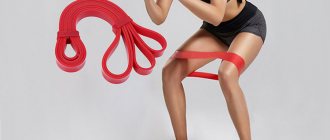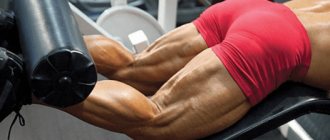Benefits of exercising with a fitness band
The main advantage of the tape is to create smooth but effective resistance through the tension of the material - rubber. The band expander is a universal means of strengthening all muscles at home. And most importantly, the tape suits everyone.
The expander does not rub, does not pinch or cut into your hands due to the width and thickness of the material. Often there are sets of several tapes of different tension levels, which allows you to select the appropriate load for each muscle.
How to choose an elastic band?
You can buy elastic tape in sports stores. In English it is called resistance band, latex band, theraband. In Russian you can find the following names: rubber band, shock absorber band, expander band, therapeutic band, theraband or Pilates band. Unlike tubular expanders, elastic bands are often found on sale in regular stores and even, as a rule, from several manufacturers.
Elastic bands have several levels of elasticity for people with different physical fitness. Typically there are three levels of resistance: soft, medium and hard, but some manufacturers may have five or even six levels of firmness. The tapes have a specific color depending on the resistance level. However, color coding may vary by manufacturer, so it is best to look at the specific product description rather than relying solely on color.
The following gradations are found:
- Yellow color: soft tape, lowest load level
- Red, green: medium load level
- Purple, lilac, blue color: rigid tape, high load level.
But we emphasize once again that color markings differ depending on the manufacturer, so it is better to look at the description of the specific product. Some online stores often sell bands of different colors, but the same resistance level. Sometimes entire sets of tapes with three levels of resistance are sold at once. Therefore, be sure to read the product description before purchasing it.
Full review of FITNESS EQUIPMENT for home
Choose a length of elastic tape that is at least 1.2 m, although they usually stretch well. However, the longer the band, the more varied exercises you can choose. In addition, a long tape can be folded in half, providing yourself with additional load. The average width of the tape should be 15-20 cm.
Like any other product, elastic band varies in quality depending on the manufacturer. Over time, the material from which the expander is made can wear out and lose strength, and this can reduce the effectiveness of exercise. The better the quality of the material, the longer it can serve you.
Elastic band or fitness band?
Nowadays, fitness bands, which are an expander ring and are a good addition to an elastic band, have become very popular. These elastic bands (mini band, resistance loop) are worn on the legs or arms and provide additional resistance when performing exercises. The fitness band is especially effective in combating problem areas on the hips and buttocks. If necessary, you can tie a long elastic band around your legs and thus replace the fitness band:
In modern strength and cardio training, fitness bands are often used. They provide excellent exercise for the upper and lower body, while being very functional. Elastic tape is used more when training the arms and back, as well as during Pilates and stretching. However, for more varied and high-quality activities, we recommend purchasing both an elastic band and a set of fitness bands. Both equipment will definitely be useful to you, especially since they are very affordable.
When choosing elastic bands and fitness bands, do not confuse them with rubber loops; these are slightly different sports equipment. It is designed for strength training and is very suitable for those who want to create a strong muscular body.
Elastic band or tubular expander?
In Western countries, tubular resistance bands are most often used for strength training, while elastic bands are more commonly used for Pilates and stretching. In Russia and the CIS countries, the tubular expander has not yet gained widespread popularity, which is why it can be so difficult to find in regular stores. In principle, for strength exercises, these two sports tools are interchangeable. But they still have differences.
Differences between a tubular expander and an elastic band:
- A tubular expander is more convenient during exercise due to the presence of handles; The elastic band can chafe your hands and even cause irritation.
- A tubular expander is less reliable than a tape: it breaks more often and wears out faster.
- An elastic band is more versatile when performing exercises because it does not have handles and is longer .
- The band is equally suitable for strength training, Pilates and stretching training. However, for strength training it is more effective to use a tubular expander.
- In Russian stores it is easier to find an elastic band than a tubular expander.
In the foreign segment, there are more ready-made video workouts with a tubular expander than with a tape. But you can also use an elastic band in such programs without much loss of effectiveness. See also: Top 12 strength training workouts with tubular resistance bands for the whole body.
Recommendations for losing weight
It is not necessary to use all the exercises in one workout; they can be divided into three sessions, each of which will contain 5 exercises. To lose weight, you should perform exercises with an elastic band for 15-20 repetitions in a circle, without pausing between exercises. At the end of the circuit, rest for a minute and repeat 4-5 more circuits. After training, you can add cardio exercises - running, jumping rope for 10-20 minutes.
General information about elastic tape
Resistance bands are becoming an increasingly popular tool for those who want to work on muscle strength and problem areas. If you have never tried exercising with a band, then you will be surprised how many benefits exercises with a seemingly ordinary elastic band bring. The elastic band is very easy to use, but extremely effective at working the muscles of the body. You will be able to work on developing muscle strength, endurance and flexibility. Moreover, this type of exercise puts minimal stress on the joints and connective tissues. As often happens, it is the simplest sports equipment that is the safest for health.
This type of sports equipment is actively used in strength training, Pilates, stretching and flexibility exercises. It is also called a rubber band, shock absorber tape or thera-band. Due to its compactness and versatility, the tape is widely used in home sports. Increasingly, professional trainers are demonstrating programs using this type of equipment.
A long, wide band made of durable rubber is popular both in gyms and at home. Elastic bands were originally used in physical therapy for the elderly and for people recovering from injuries. Now this type of expander has become a complete and very convenient alternative to free weights and exercise machines.
Let's take a closer look at the benefits of training with an elastic band. Why did this type of sports equipment become so popular and even successfully compete with dumbbells and barbells?
Benefits of training with an elastic band
- Compactness . The tape takes up very little space: after finishing your workout, just put it in a drawer until your next workout. The expander is ideal for use at home because it is very compact and suitable even for those who have limited free space.
- Lightness . The elastic band weighs almost nothing and is easy to carry. You can take it on a trip, on a business trip, on a trip, and even for a walk if you want to exercise in the fresh air. It will fit into a small bag or even a pocket.
- Low price . A rubber band can be considered one of the most inexpensive fitness tools. Its price in Russian stores starts from 200 rubles, and in foreign online stores you can order the tape for 2-3 dollars.
- Low chance of injury . When performing exercises with a rubber band, there is a simultaneous static and dynamic load throughout the entire range of motion. Therefore, training with an expander has a low impact on joints and ligaments, which reduces the likelihood of injuries and sprains.
- Work on all muscle groups . The elastic band allows you to work all the muscles of the body, but especially the muscles of the legs, arms, shoulders, chest, back, and buttocks. Almost all exercises that can be done with free weights can be done with bands.
- Adaptive load level . With a shock absorber band you will constantly work on your progress and strength development, because it has several levels of resistance depending on the elasticity of the rubber. You can also further adjust the intensity of the resistance by increasing or decreasing the tension. If you fold the elastic in several layers, you can further increase the load.
- Effective for Pilates and stretching . The rubber band is actively used in Pilates and stretching training: with its help, additional muscles are included in the work and the amplitude of movement is increased. At the same time, due to the low impact on the joints, training remains safe.
- Uniform load . The expander tape provides a uniform load along the entire stretching path, eliminating dead zones. Thanks to constant tension, the muscles do not relax at any point. This allows you to conduct your training as efficiently as possible.
- Technical performance . When performing exercises with an elastic band, the assistance of inertia during movements is excluded. For example, a barbell or dumbbell can be thrown up, thereby sacrificing technique and additionally loading the joint-ligamentous apparatus. It is impossible to do this with an expander, so you will be forced to perform the exercises technically and carefully, minimizing the risk of injury.
- Variety in training . As a rule, muscles adapt very quickly to the same movements, and this reduces the effectiveness of exercise. By adding new tools to your workouts, you will increase your workout productivity, which means you can achieve your goals much faster.
- Wider range of motion . Unlike other sports equipment, the tape can be easily worked in different directions: forward, backward, side to side and diagonally. Moreover, the angle, trajectory and range of movement are unlimited, which gives you the opportunity to work your muscles even better.
- Using familiar exercises . Band workouts often use familiar movements from traditional free weight strength training. For example, biceps curls, lateral raises, and vertical shoulder presses can be performed with both dumbbells and an expander.
- Versatility when performing exercises . The elastic band has no handles, so you can use any grip, vary the tension, or tie it in a ring around your legs. Due to the longer length, load variability is more significant.
- Suitable for women after childbirth . As a rule, after childbirth, weight training is prohibited due to the axial load on the spinal column and pelvic organs. In this case, exercises with an elastic band are recommended, which are based on the principles of static dynamics.
- Suitable for combined training . The resistance band is so versatile that you can even use it in conjunction with dumbbells, allowing you to get the benefits of two types of exercises at once:
Such obvious advantages as compactness, versatility, lightness, safety and low cost have made elastic tape one of the most popular products on the sports market. Now you can fully engage in strength training at home without the need to purchase dumbbells and barbells. However, the rubber band also has disadvantages and unpleasant features.
Disadvantages of Elastic Band Training
- Latex can cause allergies. The material for the manufacture of shock absorber tapes in most cases is latex, which is very allergenic. Redness, irritation, or swelling may occur in areas where the skin comes into contact with the tape. In this case, it is better not to practice training with an elastic band or to purchase a hypoallergenic latex-free band.
- Inconvenience during classes. During exercise, the elastic band can slip out of your hands, chafe your palms, or even cause irritation from the constant tension on its ends. In this case, you can use sports gloves with a non-slip coating.
- The elastic band wears out quickly. Unlike free weights, which have a very long lifespan, resistance bands are a short-lived product. Over time, they stretch, lose their original elasticity, or even tear.
- “Ceiling” in strength progress. Another disadvantage is that at some point it will no longer be possible for you to continue increasing the difficulty with the elastic band. Unlike free weights, the resistance level of an expander has a well-defined limit. So if your goal is to maximize strength, sooner or later you will have to turn to dumbbells, barbells or weight machines.
- It's hard to keep track of the results. When using dumbbells, you can easily track your progress because you know exactly what weights you are using in your workouts. With elastic band, there is no reliable way to quantify your performance.
Although exercises with resistance bands are biomechanically safer than exercises with dumbbells and barbells, they can also lead to damage to muscles, ligaments and tendons if the technique is incorrect. And if there is a lot of information about free weights on the correct execution of exercises (both in the literature and on the Internet), then there are much fewer detailed guidelines for training with an expander.
Therefore, be careful when training with an elastic band; before exercising, be sure to familiarize yourself with the technique of performing the exercises. If you train using a video, watch the instructor’s movements and try to follow all instructions exactly.
Recommendations for performing exercises with an elastic band for men
It is better for the stronger sex to take the rubber expander a little more seriously, because in home workouts, most often, there is not enough equipment and proper load. Thus, resistance can be used to create more load in the squat and bench press when the free weight load is already too light. You can also perform the exercises from the list using one expander, the main thing is that its density and degree of tension is maximum. Perform 10-12 repetitions in 3-4 sets.
Exercise technique
- Before starting a workout, be sure to do a warm-up so that your muscles warm up well. This will help avoid injuries or sprains.
- Perform all exercises carefully and slowly. It is good to fix and hold the tape, making sure that it does not slip.
- Control your breathing during exercise. Inhale while squeezing the elastic band, and exhale while stretching.
- For maximum effect, it is recommended to establish a healthy diet. It should be varied and balanced.
- Drink enough water for your weight (30 ml per 1 kg of weight).
Ab exercises
- In a standing position, place your feet wider than your shoulders. Raise the rubber band up, above your head and stretch it in different directions. Bend one leg at the knee and lift it sideways and up at the same time. At the same time, bend slightly to the side, with your shoulder towards your knee. Repeat the exercise 25-30 times on each side. Your hands should be tense all the time, pulling on the rubber band. Keep your stomach pulled in.
- Lie on your back. Hook the middle of the tape over your feet and hold the edges in your hands. From this position you need to raise your legs straight. At the same time, lift your shoulder blades off the floor and pull the elastic band towards you with your hands. Stay in the accepted position for several seconds, then return to the starting position. Perform 2-3 sets of 10-15 times.
- Sit on the floor. The legs remain straight and motionless throughout the exercise. Hook the tape over your feet and pull the edges in your hands. You need to pull the band tighter and move your arms behind your back. Then tilt your torso back, while spreading your arms to the sides. Repeat 10-12 times in 2-3 approaches.
Exercises for hips and buttocks
A loop is suitable for this set of exercises. Or you need to tie the edges of a long ribbon.
- Take a lying position, face down. Place the rubber band on your feet and secure it at ankle level. Your arms can be bent at the elbows and your palms placed under your forehead. Alternately raise your legs as high as possible. Watch your back, it should remain straight. Perform 15-20 times on each leg.
- Also while standing, put the loop on your legs to knee level. The tape should always be in a taut position. While holding it, perform squats. The buttock should not fall below the knees. The back is straight. Repeat 12-15 times, 2-3 approaches.
- Stand with your feet in the middle of the rubber band. Hold the edges with your hands. In this position, perform squats. The elastic band should be stretched while sitting, and stretch even more when straightening. Repeat the exercise 12-15 times, 2-3 approaches. This exercise is also suitable for weight loss.
- Place the loop on your legs at knee level. Stretch the tape with your feet shoulder-width apart. Bend your knees slightly and follow the steps. The loop should always be taut. If possible, increase the load by changing the step width. Perform the exercise for 2-3 minutes.
Exercises to strengthen your back
- Sit on the floor, stretch your legs in front of you. Pull the elastic band with your hands, hooking it over your feet. Inhale and pull the elastic band towards you as much as possible with one hand. Hold for 2-3 seconds. As you exhale, slowly return back. Repeat on both hands alternately 15-20 times.
- You must lie face down. Place your outstretched arms above your head, holding the elastic band in them. The position resembles hanging on a horizontal bar, only lying down. As you inhale, you need to lift your torso up, stretching the tape in different directions. Return to starting position. Repeat 15-20 times, 2-3 approaches.
- Take a standing position, feet shoulder-width apart. The knees are soft and slightly bent. You need to move your body forward a little and spread the rubber band in front of you with outstretched arms. Stretch the tape as much as possible and hold for a couple of seconds. Then go back. The number of repetitions is 12-15 times.
Exercises with Martens bands for hands
A Martens bandage is essentially the same rubber band. It is intended for medical use. Consists of a mixture of materials: cotton fabric, polyester and latex. Later it began to be made entirely of rubber.
Length reaches 3.5 m or 5 m. Width 5-7 cm or more.
The bandage has a wide range of applications: when providing first aid, in case of injury, for physical therapy, during rehabilitation.
Some hand exercises using Martens bands:
- Press the bandage with your foot to the floor. Take the free edge in your hand. Press your elbow to your body. Bend your arm, stretching the bandage. Keep your back straight. Repeat the exercise on the other hand. Perform 12-15 times.
- Take the same position as in the previous exercise. Hold both free edges of the bandage with your hands. At the same time raise your arms to the sides. At the same time, they should remain straight, the back is straight. Elbows turned outward. Perform 15 times.
- Place the bandage around your neck. Hold it by the edges with your hands. Elbows pressed to the body. Straighten your arms from this position, overcoming the resistance of the bandage. Then slowly return them back. Repeat the exercise 12-15 times.
Hand exercises
- Place the tape on the floor and step on it with one foot. Pull the ends in your hands. If your right leg is on the tape, then bend your right arm and slowly raise it to your shoulder. Bring it back just as slowly, without fully extending your elbow. To increase the load, you can take a dumbbell in your working hand. Then change sides. Perform 13-15 times on each side.
- Stand with your feet on the rubber band. Secure the edges with your hands. Stretch your arms slightly. Then lift them one by one. Perform the exercise slowly. Exhale with effort. Perform 20-25 times for each hand.
- Secure the rubber band with your foot to the floor. Take the other leg back and bend at the knee. Take the edges of the tape in your hands so that they are stretched. Raise your elbows and pull them back, stretching the band. Take the starting position. Repeat 20-25 times.
Back exercises
- Lie on your back, place your arms along your body. The rubber band is stretched with your hands, holding your feet in the middle. You need to raise your torso and at the same time move your elbows to the sides. The abs and buttocks should not strain. Return to the starting position and repeat the exercise another 12-15 times.
- You need to secure the tape so that it holds securely. Pull the ends of the elastic band in your hands. Bend your legs slightly at the knees. Pull the edges of the tape, placing your elbows behind your back. At the same time, the shoulders are pulled back, and the back remains straight. Perform the exercise 20 times, 2 approaches.
- Place your feet shoulder-width apart, knees slightly bent. The arms hang along the body, holding the rubber band by the edges. You need to slowly raise your shoulders to your ears, while simultaneously stretching the tape with your hands in different directions. Hold the position for a few seconds and return back. Repeat 12-15 times.
Leg exercises
- Stand with your feet on the center of the tape, so that there are equal edges on the sides. Feet are shoulder-width apart, and the ends of the elastic band are fixed in the hands. Thus, the legs and tape form a triangle. While in this position, focus on one leg and lift the other into the air to the side. Then lower the raised leg and raise the persistent leg. Perform these “rollings” for 2-3 minutes.
- Step on the tape as in the previous exercise. Cross the ends and pull in your hands. In this position you need to do side steps. Perform the exercise on each leg for 2-3 minutes.
- Place the loop on your legs and raise it to knee level. From this exercise, perform plie squats. You need to spread your legs wide and turn your toes to the sides. Keep your back straight and do not bend. Perform the exercise 18-20 times.
- Take a supine position. Raise your legs and bend your knees at an angle of 90 degrees. Throw a rubber band over your feet. Take the edges in your hands and place them behind your head. Straighten your legs and slowly return them back, overcoming the resistance of the band. To make it more difficult, you can lift your shoulders off the floor during execution and keep them raised. Repeat 15 times.
Stretching exercises
Stretching is usually done after all other exercises. Or you can make a separate workout out of it.
- Place your hands behind your back and hold it by the edges so that your palms are slightly wider than your shoulders. Raise your arms and, keeping them straight, move them above your head until they are in front of you. Repeat in the opposite direction.
- Hook the tape onto a fixed support. Take both edges in one hand. Keep it straight. Lower your shoulder and slowly turn your body in the direction of the hand with the tape. You need to feel the stretch in your pectoral muscles.
- Fix the tape in the same way. Hold it by the edges with both hands and slowly lower your body forward until it is parallel to the floor. Take a step to the side with your foot and arch your back slightly. Then repeat on the other side. The latissimus dorsi muscles are stretched.
- Sit on the floor and stretch your legs straight in front of you. Place the ribbon over your socks, holding the edges with your hands. The back and legs are straight. Pull the elastic band towards you. This causes your toes to flex and pull your hamstrings. Fix this position for 10-15 seconds, repeat 10-12 times.
- Sit on the floor. Spread your legs to the sides. Connect the ribbon into a loop. Place it behind your back and put the ends on your feet. You can adjust the resistance by changing the size of the loop or the density of the tape itself.
Exercises with a martens band for the knee
- If the knee joint pops out
- Why is it dangerous?
- Causes
- Symptoms
- Diagnostics
- Treatment Physiotherapy
- Conservative methods
- Physiotherapy
- Traditional medicine recipes
- Surgery
If the knee joint pops out
If your kneecap has fallen out, you should not reset it yourself, this is fraught with very serious consequences. In this case, you need to call an ambulance, and before it arrives, apply a cold compress to your knee and treat the skin with anesthetic ointment. It is imperative to consult a doctor, since only he can accurately determine the cause of the pathology and prescribe treatment.
Why is it dangerous?
If the knee joint has fallen out, but returned to its place on its own, then you still need to visit an orthopedist. Because if medical care is not provided in a timely manner, serious consequences are possible:
- Changes in the structure of cartilage and joint bones.
- Ligament rupture.
- Joint deformity.
- Chronic displacement of the joint, with the slightest load.
- Bleeding into the joint cavity.
- Patellofemoral arthrosis.
Causes
Dislocation of the kneecap is mainly due to injury due to damage to the muscles and ligaments surrounding the knee. As a result, during sudden movements the bone structure of the primary type is displaced. More often, habitual dislocation is observed in professional athletes due to severe overload, as a result of which the joint extends beyond the limits of the joint.
Causes of habitual dislocation:
- Knee strikes.
- Excessive stress on the legs.
- Twisting the joint.
- Violation of the integrity of the joint capsule as a result of primary traumatic dislocation.
- Joint defect.
- Failure to provide medical care in a timely manner after an injury.
- Severe mobility of the ligaments of the lower extremities.
- Failure to comply with doctor’s recommendations during the rehabilitation period after a primary dislocation.
However, not only athletes, but also average people are susceptible to this disease. The knee can fly out for the following reasons:
- Hard physical work.
- Obesity.
- Uncomfortable shoes.
- Changes in the body associated with age.
- Congenital weakness of the femoral muscle.
- Flat feet.
- Fall or careless movement of the leg.
- Playing a traumatic sport.
Symptoms
It is impossible to confuse this disease with another, since the first and main manifestation is the displacement of the kneecap to the side. This happens abruptly and unexpectedly. The victim experiences severe pain, the knee swells, the mobility of the limb is limited, and the tendons become tense.
In most cases, the knee joint moves into place on its own when the leg is flexed or extended. But there are times when an orthopedist has to correct a dislocation; in this case, you cannot delay calling an ambulance in order to avoid irreversible consequences.
Diagnostics
When the knee joint is removed, to visualize the condition of the tissues and tendons, swelling and pain are first removed. Diagnosis is carried out using the following methods:
- X-ray. Do not use in advanced stages of the disease.
- CT scan. Used if surgical intervention is required.
- Magnetic resonance imaging. The most accurate method for determining the condition of muscle tissue. Used at any stage of the disease.
- General blood analysis. Allows you to exclude infectious diseases in the knee.
Treatment
Depending on the severity of the pathology, habitual knee dislocation can be treated using the following methods: physiotherapy, conservative methods, therapeutic exercises, traditional medicine recipes, surgery.
Physiotherapy
During the recovery period of the knee joint after surgery, doctors prescribe physical procedures such as electrophoresis, paraffin lotions, and laser therapy. They improve biochemical processes, which promotes healing. The type of procedures and duration of treatment are determined by the orthopedist, depending on the injuries and age of the victim.
Conservative methods
The goal of this method is to reduce the load on the ligamentous apparatus of the knee and joint through the use of special orthopedic devices. Such devices include cuts, knee pads, bandages, plaster cast, and elastic bandage. Such methods are used if little time has passed since the injury, and in the absence of ligament rupture.
Anti-inflammatory drugs and analgesics are also used to eliminate pain. These could be injections of Lidocoin, Novocaine, or special pain-relieving ointments.
If fluid has accumulated in the knee, a puncture is performed. Next, the knee joint is fixed with a plaster.
Physiotherapy
Therapeutic exercises are prescribed by a doctor to prevent stagnation and normalize the functioning of the joint. Before performing, the knee is securely fixed with a knee pad. It is recommended to start exercises with passive exercises and gradually increase the load. Exercise therapy is performed for both limbs, the healthy leg for support, the damaged leg for development. At first, when doing it, you feel pain, which gradually goes away.
Traditional medicine recipes
To eliminate symptoms of kneecap prolapse, traditional compress recipes are often used, such as:
- Lemon. You need the juice of one lemon. Soak a bandage in it for several minutes and apply it to the sore spot.
- Burdock. Two burdock leaves are wrapped around the affected area.
- Honey. A small amount of honey is spread on the sore knee, covered with cellophane, and bandaged.
- Potato. You will need several potatoes. They are cleaned, rubbed, and the juice is squeezed out. The resulting pulp is applied to the sore spot and wrapped with a bandage.
ELASTIC MEDICAL BANDAGE, medium stretch
Elastic medical bandage - intended for the prevention, recovery and treatment of varicose veins, chronic thrombophlebitis, maintaining joints and soft tissues at rest after injuries and operations. Applying an elastic bandage to the leg, knee, ankle - used for the prevention and treatment of varicose veins, lymphatic edema, chronic thrombophlebitis, dislocations, sprains, etc., for preventive purposes - to get rid of overload and fatigue during physical activity; to prevent sprains, injuries and fractures, when playing sports, an elastic bandage is applied to the arm, leg, knee, wrist, ankle, etc. An elastic bandage is necessary as a support bandage for sprained weight-bearing joints or minor joint injury, when there is no bleeding and there is no need to apply a plaster cast. CONTRAINDICATIONS: Individual incompatibility with the components of the product's raw materials. Instructions for use are located inside the package on the label. Made from certified materials. SANITARY AND HYGIENIC PROCESSING: The elastic bandage should be treated in a hand soap solution
washing at a temperature not exceeding +35ºС, without using products containing bleaches. Do not clean with chemicals. We recommend gentle squeezing without twisting and drying flat. Ironing is prohibited. COMPOSITION: polyester - 12%, latex - 12%, cotton - 76% EXTENDABILITY: medium
STORAGE: In a dry place, at room temperature.
PACKAGING: Shrink film with information insert, instructions and 2 clips.
Shelf life: 5 years.
, CHINA
Elastic bandage price and sizes, price from 35.00 rub.
| Size | Price |
| 1.5 m x 8 cm | RUR 34.50 |
| 1.5 m x 10 cm | RUB 37.00 |
| 2.0 m x 8 cm | 44.30 rub. |
| 2.0 m x 10 cm | 45.00 rub. |
| 3.0 m x 8 cm | 57.00 rub. |
| 3.0 m x 10 cm | 65.50 rub. |
| 4.0 m x 8 cm | RUB 69.00 |
| 4.0 m x 10 cm | RUR 86.00 |











